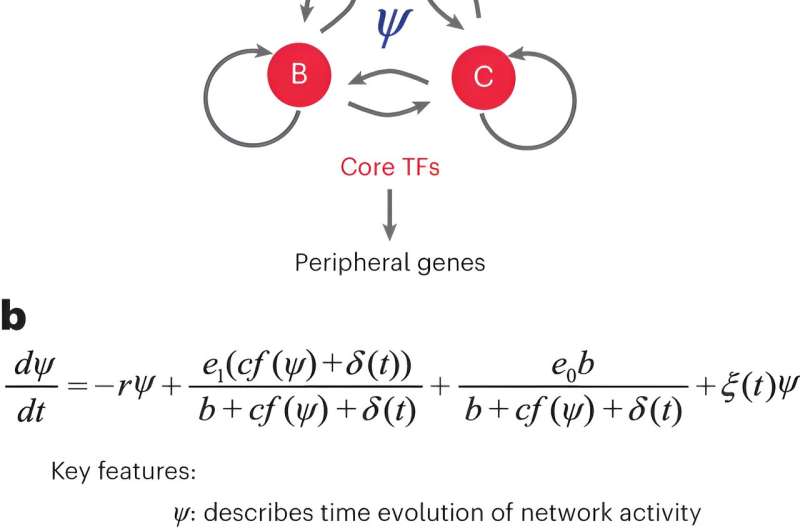This article has been reviewed according to Science X's editorial process and policies. Editors have highlighted the following attributes while ensuring the content's credibility:
fact-checked
peer-reviewed publication
trusted source
proofread
Machine learning model could enable targeted gene therapies for genetic diseases

Though almost every cell in your body contains a copy of each of your genes, only a small fraction of these genes will be expressed, or turned on. These activations are controlled by specialized snippets of DNA called enhancers, which act like skillful on-off switches. This selective activation allows cells to adopt specific functions in the body, determining whether they become—for example—heart cells, muscle cells, or brain cells.
However, these enhancers don't always turn on the right genes at the right time, contributing to the development of genetic diseases like cancer and diabetes. A team of Johns Hopkins biomedical engineers has developed a machine-learning model that can predict which enhancers play a role in normal development and disease—an innovation that could someday power the development of enhancer-targeted therapies to treat diseases by turning genes on and off at will. The study results appeared in Nature Genetics.
"We've known that enhancers control transitions between cell types for a long time, but what is exciting about this work is that mathematical modeling is showing us how they might be controlled," said study leader Michael Beer, a professor of biomedical engineering and genetic medicine at Johns Hopkins University.
Human cells are highly dynamic and change over the course of our development or in response to our environment. Beer's team was specifically interested in understanding how enhancers influence "cell fate decisions," or the process when one cell transitions into another cell type during development. Errors in cell fate decisions are a major factor in disease development.
First, the team built a machine-learning model to simulate how genes regulate each other in a cell. From there, they used large-scale selection experiments, known as genetic screens, to identify several key genes that control cell fate decisions, as well as enhancers that turn the expression of these genes on and off. Next, they used the CRISPR gene-editing system to disrupt or stimulate potential enhancers and observe the effects on gene expression. This also allowed the researchers to test which enhancers accelerated the transition of embryonic stem cells to endodermal cells, which is the first step in forming the stomach or pancreas. Finally, the team used the data from their genetic screens to model the DNA features, such as physical structure or modifying marks, that are best at predicting which enhancers will have the biggest impact on cell fate.
Using this new computational approach, the team uncovered two surprising properties about the interplay between enhancer activity and cell fates. First, enhancers that have a strong impact on gene expression were all in DNA loops enclosing the target gene—a discovery that reveals more precise information about how the genomic location of an enhancer helps to activate a target gene. Second, stimulating enhancers only influenced gene activation while the cells were transitioning from one type to another, and the effect disappeared once the transition was complete.
"This may explain why historically it has been so difficult to connect enhancer variants with the associated disease. Many of these disease-associated enhancers identified by genetics may only change gene expression significantly when the cell is transitioning to a new cell type," said Beer.
Their results suggest that CRISPR screens designed to detect enhancers during a cell state transition will have greater sensitivity. The team believes that their work could help other researchers study enhancer mutations by using models based on DNA features to predict which are most likely to impact cell fate, and design experiments to identify harder-to-detect enhancers by stimulating cell transitions.
According to Beer, the study results indicate that a cell's fate may not be set in stone and that, with more research, scientists will be able to determine which enhancers are connected to certain genetic diseases, allowing them to alter enhancer function to prevent or cure genetic maladies.
"This is a new tool to study the interactions between genes and regulatory elements such as enhancers, and that will enable insights into how to correct abnormal cellular behaviors during disease," said Beer. "We expect that our work could someday spur the development of therapies for cancer or other genomic diseases by targeting combinations of enhancers with CRISPR."
Additional study co-authors include Jin Woo Oh, Wang Xi, Dustin Shigaki of Johns Hopkins. Other authors are from Sloan Kettering Institute, Memorial Sloan Kettering Cancer Center, Weill Cornell Medicine, and the Albert Einstein College of Medicine.
More information: Renhe Luo et al, Dynamic network-guided CRISPRi screen identifies CTCF-loop-constrained nonlinear enhancer gene regulatory activity during cell state transitions, Nature Genetics (2023). DOI: 10.1038/s41588-023-01450-7




















